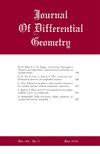退化Calabi-Yau变型附近Maurer-Cartan方程的几何性质
IF 1.3
1区 数学
Q1 MATHEMATICS
引用次数: 18
摘要
给定一个退化的Calabi-Yau变量$X$,我们构造了一个几乎微分的梯度Batalin-Vilkovisky代数$PV^{\ast,\ast}(X)$,得到了Calabi-Yau环境下扩展Kodaira-Spencer微分梯度李代数的奇异版本。在假设Hodge-to-de Rham简并性和保证Hodge束自由的局部条件下,证明了奇异Calabi-Yau变异体光滑的bogomolov - tian - todorov型无障碍定理。特别是,这为$d$ -半稳定对数光滑Calabi-Yau品种(如Friedman [$\href{https://doi.org/10.2307/2006955}{22}$]和Kawamata-Namikawa [$\href{ https://doi.org/10.1007/BF01231538}{41}$]研究)和最大退化Calabi-Yau品种(如Kontsevich-Soibelman $[\href{ https://link.springer.com/chapter/10.1007/0-8176-4467-9_9}{45}$]和Gross-Siebert [$\href{ http://doi.org/10.4007/annals.2011.174.3.1}{30}$]研究)的平滑存在提供了统一的证明。我们还演示了我们的构造如何通过应用Barannikov-Kontsevich [$\href{https://doi.org/10.1155/S1073792898000166}{2}$, $\href{https://doi.org/10.48550/arXiv.math/9903124}{1}$]的技术在扩展模空间的形式邻域$X$上产生对数Frobenius流形结构。本文章由计算机程序翻译,如有差异,请以英文原文为准。
Geometry of the Maurer-Cartan equation near degenerate Calabi-Yau varieties
Given a degenerate Calabi–Yau variety $X$ equipped with local deformation data, we construct an almost differential graded Batalin–Vilkovisky algebra $PV^{\ast,\ast}(X)$, producing a singular version of the extended Kodaira–Spencer differential graded Lie algebra in the Calabi–Yau setting. Assuming Hodge-to-de Rham degeneracy and a local condition that guarantees freeness of the Hodge bundle, we prove a Bogomolov–Tian–Todorov–type unobstructedness theorem for smoothing of singular Calabi–Yau varieties. In particular, this provides a unified proof for the existence of smoothing of both $d$-semistable log smooth Calabi–Yau varieties (as studied by Friedman [$\href{https://doi.org/10.2307/2006955}{22}$] and Kawamata–Namikawa [$\href{ https://doi.org/10.1007/BF01231538}{41}$]) and maximally degenerate Calabi–Yau varieties (as studied by Kontsevich–Soibelman $[\href{ https://link.springer.com/chapter/10.1007/0-8176-4467-9_9}{45}$] and Gross–Siebert [$\href{ http://doi.org/10.4007/annals.2011.174.3.1}{30}$]). We also demonstrate how our construction yields a logarithmic Frobenius manifold structure on a formal neighborhood of $X$ in the extended moduli space by applying the technique of Barannikov–Kontsevich [$\href{https://doi.org/10.1155/S1073792898000166}{2}$, $\href{https://doi.org/10.48550/arXiv.math/9903124}{1}$].
求助全文
通过发布文献求助,成功后即可免费获取论文全文。
去求助
来源期刊
CiteScore
3.40
自引率
0.00%
发文量
24
审稿时长
>12 weeks
期刊介绍:
Publishes the latest research in differential geometry and related areas of differential equations, mathematical physics, algebraic geometry, and geometric topology.

 求助内容:
求助内容: 应助结果提醒方式:
应助结果提醒方式:


